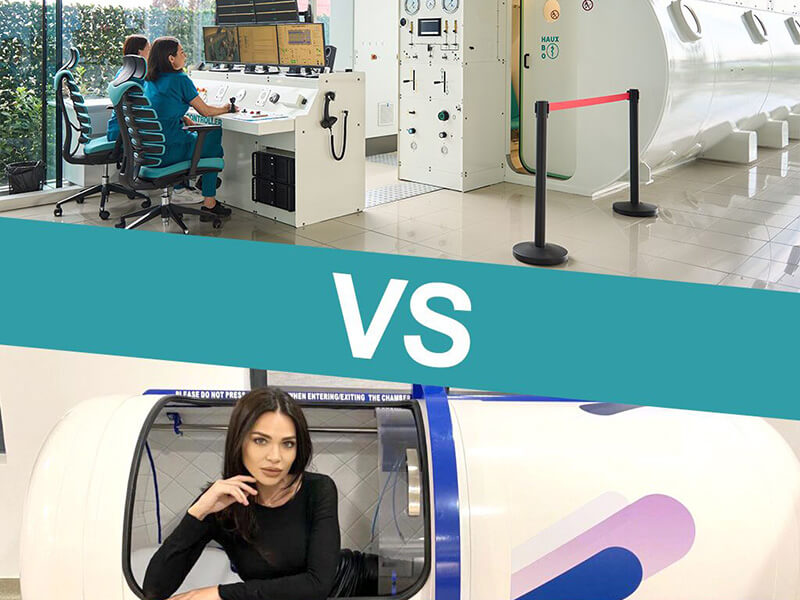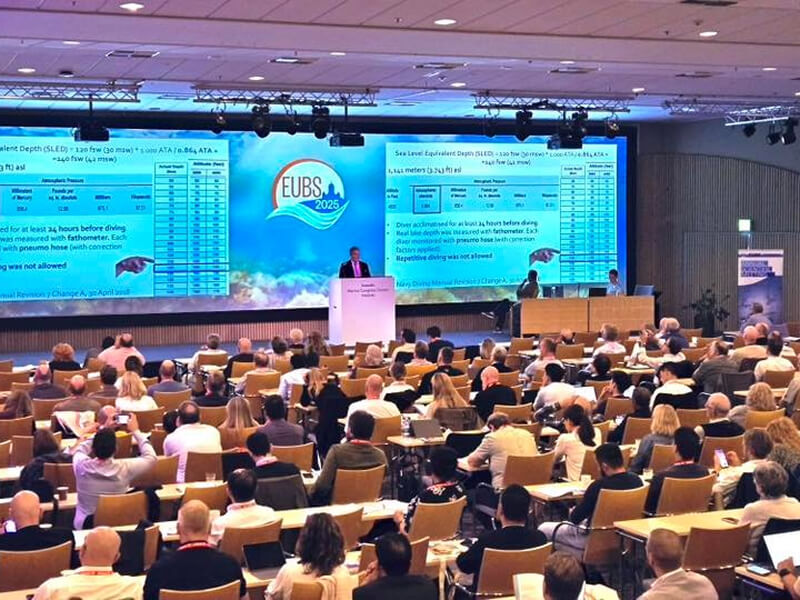
Article reviewed by: Dr. Sturz Ciprian, Dr. Tîlvescu Cătălin and Dr. Alina Vasile
How hyperbaric therapy helps the healing process
Hyperbaric therapy aids in the healing process through several specific mechanisms that enhance the body's natural ability to to regenerate and fight infections. During a hyperbaric therapy session, you are placed in a specially designed pressurized chamber where you breathe pure oxygen. This increase in pressure allows oxygen to dissolve more easily in the blood, which leads to a number of beneficial effects for healing:
1) Improved tissue oxygenation:
By breathing pure oxygen in a high-pressure environment, the concentration of oxygen in the blood increases significantly. This extra oxygen dissolves in the blood plasma and reaches injured or oxygen-deficient tissues, supporting cellular processes essential for tissue repair and regeneration. Improved tissue oxygenation is a central aspect of hyperbaric therapy and plays a crucial role in promoting healing. This process is based on the physical principle of the solubility of gases in liquids under pressure, known as Henry's law. According to this law, the amount of a gas that can dissolve in a liquid is directly proportional to the partial pressure of that gas in contact with the liquid, as long as the temperature remains constant.
In the context of hyperbaric therapy, the patient breathes pure oxygen (100%) in a hyperbaric chamber or capsule, where the atmospheric pressure is significantly increased above the standard level at sea level (1 atmosphere absolute, or ATA). This pressure rise can typically vary between 1.5 and 3 ATA. Under these conditions, the partial pressure of oxygen in the blood and in the tissues increases considerably, which allows oxygen to dissolve more easily and more abundantly in the blood plasma, not just being carried by hemoglobin.
The underlying mechanism involves several key aspects:
- Increased solubility of oxygen in the blood: At higher pressures, more oxygen dissolves directly into the blood plasma without needing to be bound to hemoglobin. This means that the tissues can receive a greater amount of oxygen, regardless of the ability of hemoglobin to transport oxygen.
- Improved oxygen diffusion: With a higher concentration of oxygen in the blood, the diffusion gradient (the concentration difference between the blood and oxygen-deficient tissues) increases, facilitating more efficient oxygen transfer from blood to tissues.
- The response to hypoxia: Damaged or injured tissues often suffer from hypoxia (lack of oxygen). By improving oxygen intake, hyperbaric therapy directly helps combat hypoxia, supporting cellular processes essential for healing and regeneration.
- Effect at the cellular level: Additional oxygen available at the cellular level supports metabolic functions, including energy production (ATP), collagen synthesis necessary for tissue repair, and optimal functioning of cells involved in healing, such as fibroblasts and endothelial cells.
Through these mechanisms, improved tissue oxygenation significantly supports the healing process, allowing tissues to repair and regenerate more efficiently. This aspect of hyperbaric therapy is essential to the effective management and healing of chronic wounds, burns, difficult infections and other conditions that benefit from increased oxygen supply.
2) Formation of new blood vessels:
The formation of new blood vessels, a process known as angiogenesis, is one of the significant effects of hyperbaric therapy that directly contributes to healing. Angiogenesis is essential for tissue repair and regeneration, as newly formed blood vessels deliver needed nutrients and oxygen to damaged areas.
In the context of hyperbaric therapy, the formation of new blood vessels is stimulated by specific mechanisms, which include:
- Stimulating the release of growth factors: Exposure to high levels of oxygen under elevated pressure stimulates cells in the body to release growth factors such as vascular endothelial growth factor (VEGF) and platelet-derived growth factor (PDGF). These factors are essential for the initiation and promotion of angiogenesis.
- Improving endothelial cell function: The cells that line blood vessels, known as endothelial cells, play a crucial role in the formation of new vessels. Hyperbaric therapy improves the function of these cells, facilitating their migration and proliferation, which is essential for the formation of new vascular structures.
- Reduction of inflammation and oxidative stress: While some degree of inflammation and oxidative stress is necessary to initiate angiogenesis, too high levels can inhibit this process. Hyperbaric therapy helps to balance these conditions, creating a more favorable environment for the formation of new blood vessels.
Through these mechanisms, hyperbaric therapy promotes angiogenesis, thus contributing to improving circulation in the affected areas and speeding up the healing process. The formation of new blood vessels is crucial for the repair of damaged tissue and tissue regeneration, making angiogenesis a fundamental aspect of the effectiveness of hyperbaric therapy in wound management and other conditions that benefit from improved vasculature and oxygenation.
3) Reduction of edema
Reducing edema (swelling caused by fluid accumulation in tissues) is one of the beneficial effects of hyperbaric therapy, which directly contributes to the healing process. The mechanism by which hyperbaric therapy contributes to the reduction of edema involves several steps and physiological processes:
- Vasoconstriction without hypoxia: Hyperbaric therapy induces vasoconstriction, that is, the narrowing of blood vessels, which could suggest a decrease in blood flow. However, due to the significantly increased levels of dissolved oxygen in the blood under the increased pressure, the tissues continue to receive a sufficient amount of oxygen. This phenomenon of vasoconstriction reduces blood flow through the edematous areas, which helps to decrease fluid accumulation and reduce edema.
- Improving lymphatic function: An efficient lymphatic flow is crucial for the removal of fluids accumulated in the tissues. Hyperbaric therapy can improve the functioning of the lymphatic system, helping to drain fluid more efficiently and reduce edema.
Through these mechanisms, hyperbaric therapy can play an important role in the management of edema, especially in cases of edema associated with chronic wounds, surgery, or trauma. Reducing edema not only helps relieve discomfort and pain associated with swelling, but also facilitates a more conducive environment for healing and regeneration, speeding up the recovery process.
4) Fights infections:
Hyperbaric therapy helps fight infections through a series of mechanisms that enhance the body's natural ability to fight pathogens and support immune processes. The main ways in which hyperbaric therapy helps in this process:
- Bactericidal and bacteriostatic effect: Certain bacteria, especially anaerobic ones, are inhibited or destroyed in high oxygen environments. Hyperbaric therapy increases tissue oxygen levels, which can have a direct bactericidal (killing bacteria) or bacteriostatic (stopping their growth) effect on these pathogens.
- Enhancing phagocytosis: Phagocytosis is the process by which immune system cells, such as neutrophils and macrophages, engulf and destroy pathogens. Oxygen is essential for the production of reactive oxygen species (oxygen free radicals), which are used by these cells to destroy bacteria. By improving tissue oxygenation, hyperbaric therapy intensifies the phagocytosis capacity of immune cells.
- Improving Immune Cell Function: High blood and tissue oxygen levels achieved through hyperbaric therapy can improve overall immune cell function. This includes the activation and proliferation of lymphocytes, which are vital in the adaptive immune response against infections.
- Synergistic effect with certain antibiotics: Hyperbaric therapy can potentiate the effect of certain antibiotics, especially those that require oxygen to be effective. By increasing tissue oxygen levels, this therapy can improve the effectiveness of antimicrobial treatments.
- Promoting tissue healing: By accelerating the process of tissue healing and regeneration, hyperbaric therapy reduces the time that wounds remain open and vulnerable to infection, thus indirectly helping to fight infection.
These mechanisms make hyperbaric therapy a valuable therapeutic option in the management of difficult infections such as osteomyelitis, diabetic infections, and infected wounds unresponsive to standard treatments.
5) Accelerates collagen formation:
Collagen formation is an essential process in wound healing and tissue regeneration, and hyperbaric therapy supports this process through several direct mechanisms:
- Stimulation of fibroblasts: Fibroblasts are the cells responsible for the production of collagen, the main component of the extracellular matrix in connective tissues. Hyperbaric therapy increases the level of oxygen available in the tissues, which stimulates the activity and proliferation of fibroblasts. Through this stimulation, collagen production is accelerated, contributing to tissue strengthening and repair.
- Improving collagen synthesis: Oxygen is a necessary cofactor for two essential enzymes in collagen synthesis: proline hydroxylase and lysine hydroxylase. These enzymes are responsible for stabilizing and crosslinking collagen chains, a crucial step in the formation of a stable extracellular matrix. By providing an increased supply of oxygen, hyperbaric therapy optimizes the activity of these enzymes, improving the quality and strength of the collagen produced.
Through these mechanisms, hyperbaric therapy plays a vital role in optimizing collagen formation, essential for tissue regeneration and effective wound healing. This makes hyperbaric therapy a valuable intervention in the management of chronic wounds, burns and other conditions that require improved tissue regeneration.
6) Reduces the risk of amputation:
The risk of amputation is reduced by hyperbaric therapy because it significantly improves the tissue healing environment through several specific mechanisms that act directly on the causes that could lead to the need for amputation. For example, in a patient with a diabetic foot ulcer, poor circulation limits the amount of oxygen reaching the wound, slowing the healing process and increasing the risk of infection and necrosis, which could lead to amputation. Hyperbaric therapy can provide the necessary oxygen directly to the affected tissues, speeding up healing and reducing the risk of serious complications.
For a deeper understanding of these mechanisms, we recommend you take a look at the scientific studies section on the Hyperbarium website . If you want personalized and direct information, it is best to make an appointment to talk to a specialist doctor.




